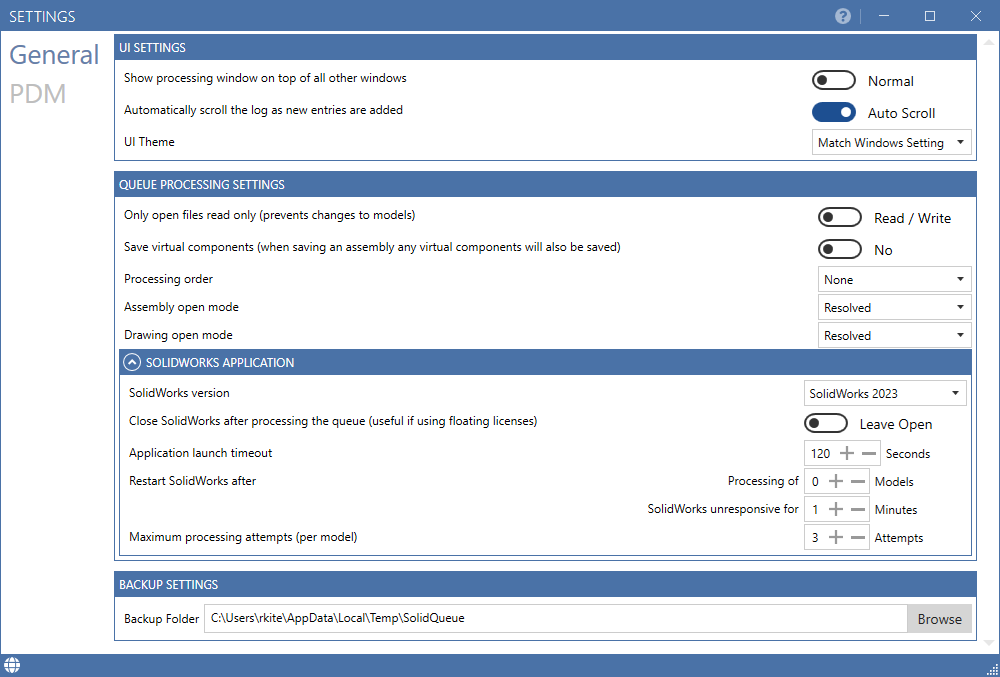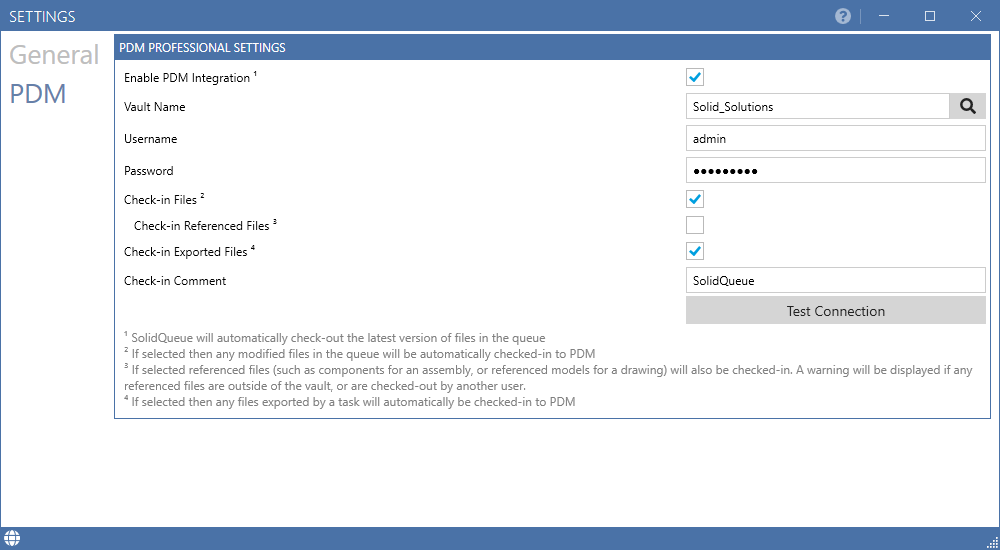SOLIDQ
Task based queuing for
SOLIDWORKS
Settings
General Settings

UI Settings
| Name | Value | Description |
|---|---|---|
| Show processing window on top of all other windows | Normal or Topmost |
How the processing window behaves with respect to other windows. This can also be toggled within the window itself. |
| Automatically scroll the log as new entries are added | Static or Auto Scroll |
If set to Auto Scroll then the log will automatically scroll such that the last added log entry is always visible. This does not occur is set to Static |
Queue Processing Settings
| Name | Value | Description |
|---|---|---|
| Only open files read only (prevents changes to models) | Read / Write or Read Only |
Determines if files should be opened as read only. If they are then no changes will be made. This option should only be set to Read Only if you intend to run tasks where the changes do not need to be saved to the model. For example running you may wish to activate a configuration and export another file format, but not save those changes in the model. |
| Save virtual components (when saving an assembly any virtual components will also be saved) | Yes or No |
When selected any direct virtual parts in the assembly will also be saved. By default this option is set to No as saving these additional files is typically unnecessary and would have a minor performance impact. However it may be useful to save virtual components if, for example, wanting to upgrade all files to a newer version of SOLIDWORKS. |
| Processing order | None or Bottom Up (default) or Top Down |
The order in which files are processed. None will follow the order set in the files list. Bottom Up (default) will process parts first, followed by sub-assemblies, then top level assemblies and finally drawings. This is the recommended option as it prevents rebuild flags in assemblies when parts or sub-assemblies are changed. Top Down is the reverse order of Bottom Up and only recommended if you have a specific requirement that files are processed in this order. See more |
| Assembly open mode | Resolved or Lightweight |
The mode in which assemblies will be opened. Lightweight is more performant than Resolved as components are not fully loaded into memory by SOLIDWORKS, however it is also more restrictive and not supported by all tasks. It components have been changed or rebuilt since the assembly was last saved then components may not be updated correctly in the assembly when using Lightweight mode. Resolved mode fully loads all components so they are always up to date. |
| Drawing open mode | Resolved or Lightweight or Detailing |
The mode in which drawings will be opened. Detailing is the most performant mode as it loads no model data into memory, Lightweight is analogous to lightweight assemblies and only loads a subset of model data, when using Resolved the model data is fully loaded into memory by SOLIDWORKS. The operations possible in SOLIDWORKS become more limited with reduced model data loaded and as such not all tasks support all opening modes. If models referenced by a drawing have been changed or rebuilt since the drawing was last saved then the drawing may not be updated correctly in the assembly when using Detailing or Lightweight mode. Resolved mode fully loads all referenced models so they are always up to date. |
| SOLIDWORKS version | A list of the installed SOLIDWORKS versions | The version of SOLIDWORKS to use. This is important as you may encounter 'Future version' errors if the models have been saved in a later version. Equally you may wish to avoid saving models in a newer version. |
| Close SOLIDWORKS after processing the queue | Leave Open or Close Application |
Provides the ability to have the SOLIDWORKS application closed once the queue has been processed. This may be useful if you have a floating SOLIDWORKS (or add-in) license that would ideally be released at the end of the process. Note that SOLIDWORKS will only be closed if there are no other documents open. |
| Application launch timeout | Number of seconds | The number of seconds to wait for SOLIDWORKS to launch (you should not need to change this from the default) |
| Restart SOLIDWORKS after processing of x models | Number of models | The number of models to process before restarting SOLIDWORKS. A value of 0 will cause this setting to be ignored. |
| Restart SOLIDWORKS after processing of x minutes | Number of minutes | SOLIDWORKS may become unresponsive at times while performing operations. SOLIDQ monitors SOLIDWORKS and starts a timer when it becomes unresponsive. This setting determines how many minutes SOLIDWORKS can be unresponsive for, before restarting it. |
| Maximum processing attempts (per model) | Number of attempts | The number of attempts that will be made to process a file in the queue before skipping it. An attempt may fail if an error occurs, or SOLIDWORKS becomes unresponsive and has to be restarted. This setting ensures that the queue doesn't grind to a halt if one file cause an issue. |
Backup Settings
| Name | Value | Description |
|---|---|---|
| Backup Folder | Folder Path | The folder in which to store backup copies of the processed models. SOLIDQ will create a new sub folder with a timestamped name in the specified location. All processed files will be copied here before they are opened by SOLIDQ to ensure you can revert any undesired changes*. |
[!CAUTION] *You should always take a backup of your data set, do not rely on this backup behaviour
PDM Settings

PDM integration is only available in SOLIDQ Premium. Once all settings are entered you can utilise the 'Test Connection' button to ensure that a PDM vault connection can be established.
PDM Professional Settings
| Name | Value | Description |
|---|---|---|
| Enable PDM Integration | Yes or No |
If checked, PDM integration is enabled. This means that any files in the queue that are located in the PDM vault will be checked-out prior to tasks running (unless SOLIDQ is in read-only mode, in which case the latest version will be retrieved but not checked-out). If not enabled then SOLIDQ will run on the local version (if any) and changes cannot be saved unless the files are already checked-out to the user. |
| Vault Name | Name of PDM vault | The name of the PDM vault to integrate with (use the search function to list all visible PDM vaults). |
| Username | The PDM user to login as | The username of the PDM user that SOLIDQ will use to login to the PDM vault. |
| Password | The PDM login password | The password for the specified username to login to the PDM vault as. |
| Check-in Files | Yes or No |
If checked any files in the queue that are modified will be checked-in to the PDM vault automatically. |
| Check-in Referenced Files | Yes or No |
If checked referenced files (such as components for an assembly, or referenced models for a drawing) will also be checked-in. A warning will be displayed if any referenced files are outside of the vault, or are checked-out by another user. |
| Check-in Exported Files | Yes or No |
If checked then any additional files created by a task in the queue will be added to, and / or checked-in to the PDM vault automatically. |
| Check-in Comment | The check-in comment | This is the comment that is used during file check-in to the PDM vault. |